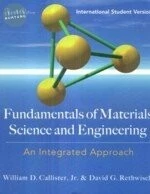
| 定價: | ||||
| 售價: | 1650元 | |||
| 庫存: | 已售完 | |||
| LINE US! | ||||
| 此書為本公司代理,目前已售完,有需要可以向line客服詢問進口動向 | ||||
| 付款方式: | 超商取貨付款 |

|
|
| 信用卡 |

|
||
| 線上轉帳 |

|
||
| 物流方式: | 超商取貨 | ||
| 宅配 | |||
| 門市自取 |
為您推薦

類似書籍推薦給您

類似書籍推薦給您
書名:Fundamentals of Materials Science and Engineering: An Integrated Approach 6/e 作者:CALLISTER 出版社:John Wiley 出版日期:2022/00/00 ISBN:9781119820543 目錄 TABLE OF CONTENTS 1. Introduction 2. Atomic Structure and Interatomic Bonding 3. Structures of Metals and Ceramics 4. Polymer Structures 5. Composites 6. Imperfections in Solids 7. Diffusion 8. Mechanical Properties 9. Dislocation, Deformation, and Strengthening Mechanisms 10. Failure 11. Phase Diagrams 12. Phase Transformations 13. Electrical Properties of Materials 14. Types and Applications of Materials 15. Processing of Engineering Materials 16. Corrosion and Degradation 17. Thermal Properties 18. Magnetic Properties 19. Optical Properties 20. Economic, Environmental and Societal Issues in Materials Science and Engineering Appendix A: The International System of Units (SI) Appendix B: Properties of Selected Engineering Materials Appendix C Costs and Relative Costs for Selected Engineering Materials Appendix D Repeat Unit Structures for Common Polymers Appendix E Glass Transition and Melting Temperatures for Common Polymeric Materials Appendix F Characteristics of Selected Elements Appendix G Values of Selected Physical Constants Appendix H Periodic Table of the Elements Mechanical Engineering Online Module Library of Case Studies Case Study CS1—Materials Selection for a Torsionally Stressed Cylindrical Shaft Case Study CS2—Automobile Valve Spring Case Study CS3—Failure of an Automobile Rear Axle Case Study CS4—Artificial Total Hip Replacement Case Study CS5—Intraocular Lens Implants Case Study CS6—Chemical Protective Clothing

類似書籍推薦給您

類似書籍推薦給您
This comprehensive guide to sustainable energy builds robust connections between abstract theory and practical applications, providing students with a global perspective on this most timely subject. Includes a succinct refresher on essential thermodynamics, fluid mechanics and heat transfer, giving students a solid foundation on which to build. Introduces technologies for hydropower, biomass, geothermal, ocean, solar and wind energy, and fuel cells, with material on nuclear energy, fossil fuel generation and future energy directions, providing a consistent framework for analyzing past, present and future energy systems. Provides coding examples, and real-world case studies, giving students experience in applying theory to practice. Supported by topics for classroom debate, video solutions, and links to online resources, to interactively engage students and inspire further exploration. With a consistent structure and pedagogy, over 160 end-of-chapter problems, and solutions for instructors, this is the ideal introduction for senior undergraduate and graduate students, and a resource for energy professionals. The most comprehensive, up-to-date guide to sustainable energy A balance of theory and real-world applications, including a wide variety of global case studies Sections on the use of fossil fuels, nuclear energy, renewable energy technologies, and the future of sustainable energy

類似書籍推薦給您
商品描述 本書序言 ●Revised and updated references, data, and examples throughout ●New and expanded chapter problems and exercises ●Additional subsets of instructor-only problems and materials for laboratory exercises ●Additional show/hide problems and solutions in the enhanced ePub edition of the text ●Updated problems reflecting current Fundamentals of Engineering (FE) and Principles and Practice of Engineering (PE) exams 本書特色 ●Focuses on modern sustainable design concepts, processes, and practices ●Applies foundational principles of physics, chemistry, biology, and sustainability to creating solutions for managing and mitigating environmental problems ●Places emphasis on global issues such as pollution prevention and resource recovery ●Explains energy and mass balance concepts using numerous clear and engaging example problems ●Provides a coherent and unified approach to life cycle assessment and thinking development ●Features effective pedagogical tools, including numerical assessment and design problems, research activities, discussion topics, and extensive online learning resources ●Includes extensive teaching materials for instructors, such as lecture slides, active learning exercises, homework assignments, classroom activities, and a solutions manual 目錄大綱 Chapter One Sustainable Design, Engineering, and Innovation Chapter Two Environmental Measurements Chapter Three Chemistry Chapter Four Physical Processes Chapter Five Biology Chapter Six Environmental Risk Chapter Seven Water: Quantity and Quality Chapter Eight Water Treatment Chapter Nine Wastewater and Stormwater: Collection, Treatment, Resource Recovery Chapter Ten Solid-Waste Management Chapter Eleven Air Quality Engineering Periodic table of the elements Answers to Selected Problems